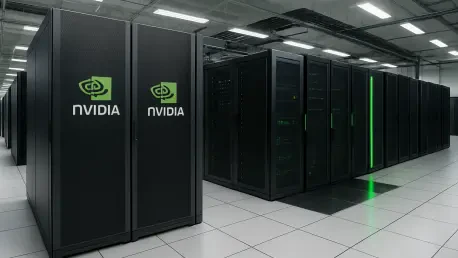Imagine a world where artificial intelligence (AI) drives every major technological breakthrough, from autonomous vehicles to personalized healthcare, and at the heart of this revolution lies a single company powering the infrastructure. Nvidia, a titan in AI hardware, has been that force, with its data center solutions fueling the computational needs of global tech giants. Yet, a subtle tremor has emerged in its seemingly unstoppable ascent—a rare decline in compute revenue that prompts a deeper look into its current standing. This review explores Nvidia’s data center technology, dissecting its performance, challenges, and future potential in a rapidly shifting landscape.
The data center segment, a cornerstone of Nvidia’s portfolio, encompasses high-performance GPUs and CPUs that form the backbone of AI infrastructure. Historically, this division has been a primary engine of growth, positioning Nvidia as a leader in the tech industry’s AI revolution. As cloud computing and machine learning workloads surge, understanding the dynamics of this segment becomes essential to gauging Nvidia’s long-term trajectory.
In-Depth Analysis of Data Center Performance
Compute Revenue: A Surprising Dip
In the latest quarterly results for the current fiscal period, Nvidia reported an unexpected decline of 0.9% in data center compute revenue compared to the prior quarter, marking the first sequential drop in a decade. This segment, which includes sales of GPUs and CPUs critical for AI processing, has long been synonymous with consistent growth. While the decrease appears marginal, it signals a potential shift in market dynamics or saturation in certain areas of demand.
The implications of this plateau are worth scrutinizing. Visual data from industry analyses suggest that Nvidia’s once-unassailable dominance in AI hardware might be encountering headwinds. Could this be an early indicator of market maturity, or is it merely a temporary hiccup in an otherwise robust growth story? The answer remains unclear, but it underscores the need to examine external factors influencing performance.
Networking Segment: A Bright Spot
In stark contrast to the compute downturn, Nvidia’s networking technology, encompassing InfiniBand and Ethernet interconnects, has shown remarkable strength, nearly doubling in revenue to $7.25 billion in the same period. This surge highlights a pivot in customer priorities toward building robust infrastructure for large-scale AI clusters. Interconnects are becoming as critical as raw computational power in scaling AI systems.
This growth in networking revenue offers a buffer against compute losses, suggesting that Nvidia’s data center ecosystem remains versatile. Customers appear to be investing heavily in the foundational elements that enable efficient data transfer across AI workloads. This trend could redefine how Nvidia balances its portfolio, potentially prioritizing interconnect solutions in future innovations.
External Factors Impacting Growth
Geopolitical tensions, particularly export restrictions to key markets like China, have cast a shadow over Nvidia’s compute sales. These limitations have curtailed access to a significant region, dampening expected revenue in a space where demand for AI hardware remains high. Such barriers illustrate how external policies can disrupt even the most dominant players in tech.
Beyond geopolitics, broader market dynamics add layers of complexity. Competitive pressures from rival chipmakers and evolving customer needs for customized solutions are reshaping the landscape. Nvidia must navigate these challenges to maintain its edge, as reliance on traditional compute models alone may not suffice in a diversifying industry.
Risks Tied to Customer Concentration
A critical vulnerability in Nvidia’s data center business lies in its dependency on a narrow base of major clients. Over 50% of revenue in this segment stems from just three customers, with one accounting for more than 20% of sales. This concentration poses a substantial risk, as any shift in purchasing patterns or strategic decisions by these key players could ripple through Nvidia’s financial stability.
Such reliance underscores the importance of diversifying the customer base. While large clients provide a steady revenue stream, they also create a fragile foundation susceptible to abrupt changes. Nvidia’s ability to expand its reach to smaller enterprises or emerging markets could mitigate this exposure in the long run.
Future Prospects and Innovations
Despite recent setbacks, optimism surrounds Nvidia’s data center trajectory. Leadership, including CEO Jensen Huang, projects record-breaking performance in the fiscal years spanning 2025 to 2027, driven by sustained demand for AI infrastructure. The Blackwell GPU lineup, already sold out into the next year, exemplifies the market’s confidence in Nvidia’s cutting-edge offerings.
Moreover, ongoing development of new platforms signals a commitment to innovation. These advancements aim to address evolving needs in AI and high-performance computing, potentially reigniting growth in compute revenue. If Nvidia can maintain this momentum, the current dip might be remembered as a minor blip rather than a turning point.
Strategic Challenges and Considerations
Balancing strengths with emerging vulnerabilities defines Nvidia’s current position. The compute revenue decline, while small, pairs with risks from customer concentration and export limitations to create a complex outlook. These factors highlight the need for strategic adjustments to safeguard against potential disruptions.
Adapting to a competitive and geopolitically charged environment will be paramount. Nvidia might consider accelerating efforts to penetrate new markets, diversify its client portfolio, and invest in alternative technologies that complement its core offerings. Such moves could fortify its resilience against unforeseen market shifts.
Reflecting on Nvidia’s Path Forward
Looking back, this evaluation of Nvidia’s data center technology reveals a mixed landscape of triumphs and challenges. The slight decline in compute revenue stands out as a historic anomaly, tempered by robust growth in networking solutions. External pressures and customer dependency add layers of concern that temper the otherwise strong demand for innovative products like Blackwell GPUs.
Moving ahead, Nvidia needs to prioritize broadening its customer base to reduce reliance on a few key players. Exploring untapped markets and doubling down on interconnect technologies offer viable paths to sustain growth. Additionally, navigating geopolitical constraints with agility could position Nvidia to reclaim its upward trajectory. The road ahead demands proactive strategies to transform potential vulnerabilities into opportunities for reinvention.









